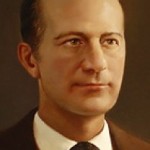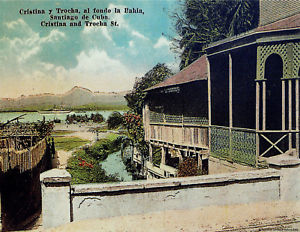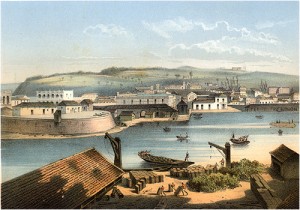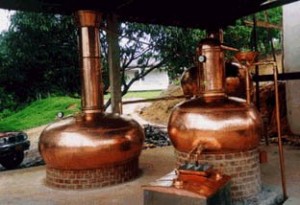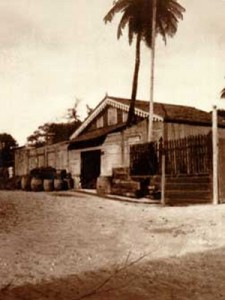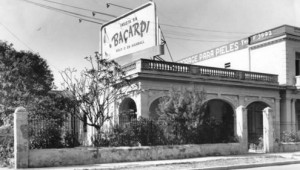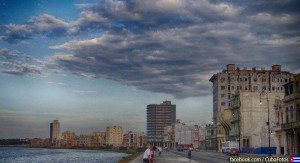LOS MISTERIOS DE LA FÓRMULA SECRETA DEL RON BACARDI.
Mientras contemplaba el mar y pensaba en su esperada fortuna, Don Facundo Bacardí Mazó gustaba repetir, en voz muy baja, la máxima que guiaba sus empeños de predestinado: “Els catalans de les pedres fan pans” (los catalanes, de las piedras hacen panes), frase que también resumía el espíritu emprendedor del pueblo que lo había visto hacer.
Facundo era oriundo del pueblo de Sitges, en Barcelona, y de su origen portuario le venia el amor al mar. Junto a varios de sus ocho hermanos se había asentado en Santiago de Cuba y, el 5 de agosto de 1843, cumplidos los 30 años, desposó a la joven Lucía Victoria Moreau, una espléndida muchacha de 21 años, hija natural de una emigrada franco-haitiana y de un capitán de Napoleón, dueño del cafetal El Amor, con la cual formaría la estirpe de los Bacardí Moreau.
Desde su asentamiento en Santiago, Facundo y sus hermanos trataron de imponer su genio comercial. En la misma década del 30, Juan y Magón Bacardí Mazó aparecen asociados con otros catalanes en la regencia de un almacén de víveres y ferreterías, así como en una pulpería. Mientras, el mismo año de su matrimonio, Facundo establece con Juan Carbonell y Bory una tienda de mercancías varias en la calle Enramadas y poco después, abren en El Cobre una mercería. Sin embargo, las crisis comerciales que azotan a Santiago en la década de 1850-60 impiden el despegue de los empecinados hermanos.
Eran los días penosos del que sufre pensando cómo comenzar un pequeño negocio, sin mucho capital pero con una gran disposición de triunfar y una voluntad a toda prueba. Don Facundo Bacardí y Mazó en cada mañana de su vida, desde aquellos lejanos tiempos de su asentamiento en Santiago de Cuba, cuando era muy joven y muy pobre, buscaba cualquiera de las muchas elevaciones de la villa y pasaba los primeros minutos del día contemplando la plácida tranquilidad de un mar envuelto entre las montañas. Y entonces pensaba: y siempre pensaba que por aquel mismo mar, alguna vez, le entraría la fortuna definitiva que durante tantos años había perseguido, hasta ahora sin éxito.
COMIENZA LA HISTORIA BACARDI.
Cuentan que corría el año de 1860 y que Santiago recibía los efluvios de una nueva crisis económica. Facundo Bacardí, a bordo de La Esperanza, partió de la ciudad mientras su esposa Lucía Victoria, desde el muelle, le daba el adiós con un pañuelo malva perfumado con extracto de magnolias.
La última escala de la goleta ‘La Esperanza’, que daba viajes de Santiago a las islas menores, a la isla francesa de La Martinica. Pero había llegado ya el mes de octubre y un ciclón puntual empezó a barrer el Caribe. La nave,fondeada en puerto, espero la muerte del huracán y, mientras tanto, Facundo Bacardí empleo su ocio en beber el ron pendenciero que se vendía en las tabernas del puerto. Una noche de tragos quiso la suerte que Facundo Bacardí, en medio de una antológica borrachera, le prometiera a un francés rubio y refinado, un sitio en La Esperanza para trasladarlo a Santiago, de donde el viajero debería partir hacia la lejana patria. Y, aunque el día marcado para el regreso Facundo no recordaba el rostro del francés, se dijo que promesas son promesas y lo dejó embarcar con sus dos maletas.
Facundo Bacardí, coqueteando con su destino, hizo asi una rápida amistad con aquel hombre que en sus maletas solo llevaba buenos litros de ron dulzón y extrañamente despojado de la dureza del famoso ron jamaicano que bebían los santiagueros. La amistad se tornó tan profunda que, mientras esperaba la salida del barco que lo llevaría a Marsella, el francés se alojó en la casa de Facundo y, cada mañana, salía con él a contemplar el inmenso mar.
El día anterior a su partida, cuando bebían ya la ultima garrafa de ron, el francés le confesó a su amigo catalán que su oficio era vinatero y, en prueba de agradecimiento eterno, le confesaría la fórmula secreta para fabricar aquel ron suave y fino, fuerte y agradable a la vez, con el que podría adueñarse del mercado de licores de la caliente villa de Santiago de Cuba. El francés habló y nació así el misterio de Bacardí y la historia de la fábrica de ron que, 128 años después, sigue produciendo el mejor ron del mundo, gracias a la celosa preservación de un simple y ancestral secreto.
En aquellos días de 1860, cuando la mítica historia del catalán Facundo Bacardí lo ubica aprendiendo la técnica licorera del nombrado vinatero francés, Santiago de Cuba, no era, ni mucho menos, la plaza fuerte de los licores cubanos. Por aquel entonces solo cuatro alambiques funcionaban con fines comerciales en la cálida ciudad y de sus torres de destilación apenas brotaba un aguardiente peleón y agresivo al paladar. El ron, en verdad, era patrimonio de la vecina Jamaica.
El origen concreto de ese invento prodigioso llamado ron es otro de los misterios de su historia . En términos breves y científicos, el ron es la bebida perteneciente a la familia de los licores que se obtiene por la fermentación y subsiguiente destilación de las mieles del azúcar, y es sometido después a procesos de mezclas y envejecimientos. Por eso algunos suponen que la génesis de la palabra ron proviene de sacharum, aunque desde 1650 existía en la Antillas un tipo de aguardiente conocido como rumbillion, antiguo vocablo Devonshire que significa turbulencia o tumulto, términos que, con el tiempo, se han convertido en buenos sinónimos de ron.
De los cuatro alambiques existentes en Santiago hacia 1862, uno, El Marino, propiedad de Manuel Idral y Compañía, el 24 de febrero pasó a manos de José Bacardí y Compañía, por lo que esta fecha es considerada como la del nacimiento oficial de lo que sería la fábrica de Ron-Bacardí.
LA FORMULA SECRETA.
Es cuando aparecen los primeros misterios en torno a la fabricación de este ron santiaguero.: rápidamente el duro aguardiente que se obtenía de los alambiques adquiridos empieza a mejorar su sabor, en virtud de las mezclas paulatinas y los añejamientos que lo convierten en ron. Al mismo tiempo, los Bacardí y Bouteiller dejan envejecer en barriles de roble cierta cantidad de aguardiente puro, que duerme en sus bodegas durante doce años y da lugar al primer ron genuinamente cubano: el cotizadísimo Bacardí 1873 o Extra Seco, exento de cualquier tipo de mezclas. Así, entre 1862 y 1874, las bebidas producidas por la fabrica de la calle Marina baja No.32, fueron mejorando su calidad gracias a mezclas insospechadas por otros licoreros cubanos y, poco a poco, empezaron a trascender el mercado nacional. Había nacido al fin, en Santiago de Cuba, y por medios enigmáticos, un ron suave y agradable, el mismo que apenas 30 años después de creado regresaría de la Feria Mundial de París con una Medalla de Oro y se convertiría en la marca de los Reyes de España. “El Rey de los Rones y el Ron de los Reyes”.
Apenas extraido de un barril el primer litro del excelente Ron Extra Seco, justamente el 10 de Noviembre de 1874, su hermano Jose Bacardi, hasta entonces socio principal de la empresa, había decidido abandonar un negocio que rendía muy escuálidas ganancias y exigía la paciencia de un condenado. Pero, un mes despues, el otro socio, el frances Jose Leon Boutellier tambien abandonaba el juego y dejaba a Facundo como único dueño de la raquítica fábrica que en doce años solo había dejado pérdidas. Es entonces cuando el viejo Facundo, decide fundar su propio clan. El último día de aquel año 1874, don Facundo convocó a sus hijos Emilio y Facundito Bacardí Moreau y, con el tono ceremonioso que lo caracterizó, creó el consorcio Bacardí-Moreau: le confio a sus hijos el secreto del vinatero frances y les exigió que aquella fórmula, así como las acciones de la empresa ruinosa, que pronto dejaría de serlo, solo podían pasar de padres a hijos hasta la eternidad…
Don Facundo Bacardí y Mazó, con setenta y cuatro años de residencia en la tierra y más de cincuenta en Santiago de Cuba, murió al fin el 9 de mayo de 1886, dejando como herencia una fábrica de licores artesanal y pequeña, pero muchos, muchos barriles repletos de ron. Y un secreto.
Fue allí, en la misma calle Marina baja Número 32 en Santiago de Cuba, en tres naves construidas por los descendientes del viejo Don Facundo, donde se produjo hasta 1960 el ron Bacardí, ya famoso en todo el universo. Pero ese mismo año, en virtud de la Ley de Nacionalización, la fabrica pasó a ser propiedad estatal bajo la administración de los hermanos Castro.
Pero los últimos dueños del consorcio, los descendientes del viejo Don Facundo Bacardi, habían partido, llevándose consigo los secretos que, durante un siglo, habían normado la producción del mejor ron del mundo.
Agencies/Carlos Diaz/Hist.Cubana/InternetPhotos/TheCubanHistory.com
The Cuban History, Hollywood.
Arnoldo Varona, Editor.
THE MYSTERIES OF THE SECRET FORMULA OF RON BACARDI.
While contemplating the sea and thought about his expected fortune, Don Facundo Bacardi Mazó fond of repeating, in a low voice, high guiding their efforts predestined, “Els de les Catalans fan pedres pans” (Catalan, from stones make bread ), a phrase that also summarized the entrepreneurial spirit of the people who had seen.
Facundo was from the village of Sitges, in Barcelona, and its source port will love coming to sea. Along with several of his eight siblings had settled in Santiago de Cuba, and on August 5, 1843, 30 years of age, married the young Lucía Victoria Moreau, a beautiful girl of 21, a natural daughter emigrated Franco Haitian and a captain in Napoleon, owner of the plantation Love, with which form the lineage of Bacardi Moreau.
Since its establishment in Santiago, Facundo and his brothers tried to impose their commercial genius. In the decade of 30, Juan and Bacardi Mazó Magón are associated with other Catalans in the regency of a grocery store and hardware stores, as well as a grocery store. Meanwhile, the same year of their marriage, set with Juan Facundo Bory Carbonell and miscellaneous goods shop on the street Enramadas and soon after opened a haberdashery in El Cobre. However, the commercial crises that plague Santiago in the early 1850 to 1860 prevented the departure of the brothers bent.
Those were the days of painful suffering thinking how to start a small business with a small capital but with a great willingness to succeed and a willingness foolproof. Don Facundo Bacardi and Mazó every morning of his life, from those early days of their settlement in Santiago de Cuba, when he was very young and very poor, seeking any of the many elevations of the villa and spent the first few minutes of the day watching the placid tranquility of a sea covered the mountains. And then I thought, and I always thought that at that same sea, sometime, will enter the final fortune had pursued for so many years, so far without success.
BACARDI STORY BEGINS.
They say that 1860 was the year that James received the effluvia of a new economic crisis. Facundo Bacardi, aboard La Esperanza, left the city while his wife Victoria Lucia, from the dock, gave the farewell with a scented handkerchief mallow extract magnolias.
The last leg of the schooner ‘La Esperanza’, overlooking Santiago trips to the smaller islands to the French island of Martinique. But he had come October and timely cyclone began to sweep the Caribbean. The ship anchored in port death hope hurricane and in the meantime, Facundo Bacardi use their leisure in the rowdy drinking rum sold in the taverns of the port. A night of drinking luck would Facundo Bacardi, amid an anthology drunken promise him a French blond and refined, a site in La Esperanza for transfer to Santiago, where the traveler should leave for the distant homeland. And although the day marked for return Facundo not remember the face of the French, it was said that promises are promises and let him board with his two suitcases.
Facundo Bacardi, flirting with their destiny, so did a quick friendship with the man who had only been in their suitcases liters of good sweet rum and oddly stripped hardness famous Jamaican rum drinkers of Santiago. The friendship became so deep that, while awaiting the departure of the boat that would take him to Marseilles, the French stayed in the house of Facundo and every morning, leaving him to contemplate the immense sea.
The day before his departure, and when they drank the last bottle of rum, French Catalan confessed to his friend that his office was vintner and in proof of eternal gratitude, we confess the secret formula to make this soft and fine rum strong and nice at the same time, with which it could seize liquor market hot town of Santiago de Cuba. Spoke French and was born of the mystery and history of Bacardi rum factory that 128 years later, still producing the best rum in the world, thanks to the jealous preservation of a simple and ancient secret.
In those days of 1860, when the legendary history of Catalan Facundo Bacardi liquor locates learning technique named the French vintner, Santiago de Cuba, was not far from the fortress of Cuban spirits. At that time only four distilleries operating commercially in the warm city and its distillation towers sprouted just a bully and aggressive spirit on the palate. Rum, indeed, was the patrimony of the neighboring Jamaica.
The specific origin of this wondrous invention called Rum is one of the mysteries of history. In scientific terms and short, rum is the drink belonging to the family of spirits obtained by fermentation and subsequent distillation of the sweetness of sugar, and is then subjected to aging processes and mixing processes. So some suppose that the origin of the word rum comes from Sacharum, although since 1650 the Netherlands was a type of brandy known as rumbillion, old word meaning Devonshire turbulence or turmoil, terms, over time, have become looking good rum.
Of the four stills existing in Santiago around 1862, one Marine, owned by Manuel Idral and Company, February 24 passed into the hands of Joseph Bacardi and Company, so this date is considered the official birth of what would be factory-Ron Bacardi.
THE SECRET FORMULA.
It is when the first mysteries appear around making this rum .: quickly santiaguero hard liquor that was obtained from the acquired stills starts to improve taste, under the gradual blends and añejamientos that make rum. At the same time, Bacardi and Bouteiller are aged in oak barrels certain amount of pure spirits, sleeping in their cellars for twelve years and leads to the first authentic Cuban rum Bacardi cotizadísimo 1873 or the Extra Dry, free from any type of mixtures. Thus, between 1862 and 1874, drinks produced by the factory floor Marina Street No.32, were improving their quality through mixtures unsuspected by other Cubans Licoreros and gradually began to transcend the domestic market. She was born at last, in Santiago de Cuba, and enigmatic media, a mild and pleasant rum, the same as just 30 years after I created back to the World Fair in Paris with a Gold Medal and became the mark kings of Spain. “The King of Rums and Ron de los Reyes”.
Just a barrel extracted from the first liter of excellent Extra Dry Rum, just the November 10, 1874, his brother Jose Bacardi, previously senior partner of the company, had decided to abandon a business that paid very skinny profits and demanded patience a convict. But, a month later, the other partner, the French Jose Leon Boutellier also left the game and left Facundo as sole owner of the rickety factory in twelve years had only caused losses. That’s when the old Facundo, decided to found his own clan. The last day of that year 1874, Don Facundo summoned his sons Emilio and facundito Bacardi Moreau and the ceremonious tone that characterized him, he created the consortium Bacardi-Moreau: I trust their children the secret of French vintner and demanded that that formula as well as the actions of the ruined company that would soon cease to be, could only pass from parents to children until eternity …
Don Facundo Bacardi and Mazo, seventy-four years of residence in the land and over fifty in Santiago de Cuba, finally died on May 9, 1886, leaving as a legacy a small handicraft factory and liquors, but many, many rum filled barrels. And a secret.
It was there, on the same street Marina Low Number 32 in Santiago de Cuba, in three ships built by the descendants of the old Don Facundo, which was produced until 1960 Bacardi rum, now famous throughout the universe. But that same year, under the Nationalization Law, the factory became state property under the administration of the Castro brothers.
But the ultimate owners of the consortium, the descendants of the old Don Facundo Bacardi, had already departed, taking with them the secrets that for a century had regulated the production of the best rum in the world.
Agencies / Carlos Diaz / Hist.Cubana / InternetPhotos / TheCubanHistory.com
The Cuban History, Hollywood.
Arnoldo Varona, Editor.



